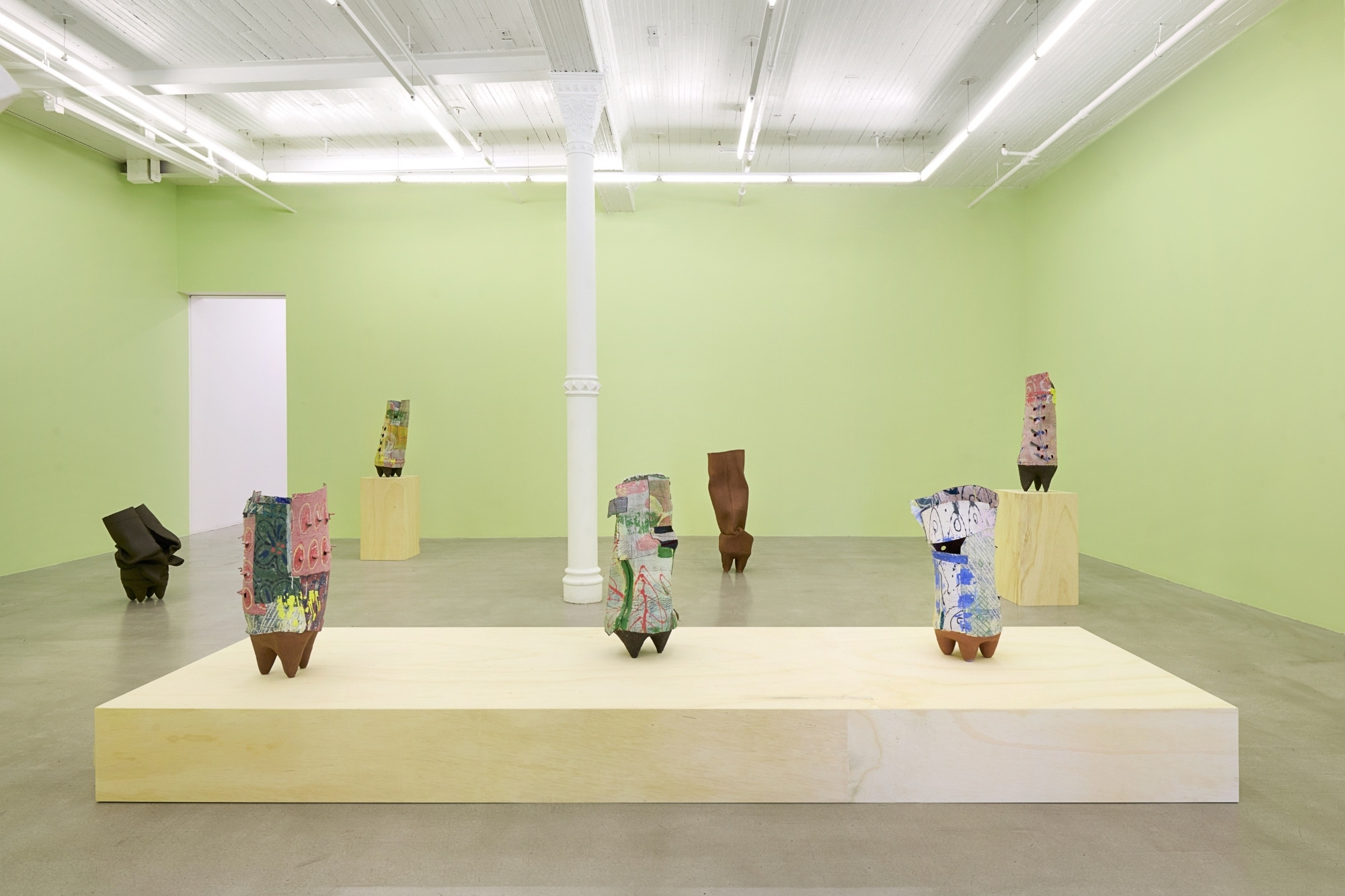By Doug Navarra
Ranti Bam premiered in May 2024 at the James Cohan Gallery, her first New York City exhibition titled Anima. I always think that my first and immediate impression is something significant when I first walk into any exhibition. This show is no different in that I stopped before entering the main gallery and took a deep breath. The installation at first appeared to me as a cluster of anthropomorphic forms, huddled in a crouched posture. They form a distinct group, as though assembled in anticipation of an event waiting to take place. This is further accentuated by a landscape installation format that positions these vessel-like ceramic works at varying heights. Some rest on free-standing platforms, while others occupy the floor, pedestals, or built-in display structures. The entire gallery is adorned with a chartreuse-colored paint, drawing inspiration from Ranti’s fascination with Hieronymus Bosch’s masterpiece, The Garden of Earthly Delights. In that painting, Eve symbolically emerges from the collective unconscious as an integration of diverse elements within the psyche. As the foundational substance underlying all existence, founded in Bosch’s painting, Eve is, by contrast, selectively present, embodying the Jungian archetype of the primal feminine. Ranti Bam embodies a unique identity. Born in Nigeria, she left the country at the age of six to live with her parents in the UK. There, she received her education while skillfully balancing and maintaining her family ties back in Nigeria.
Within the context of this exhibition the archetypal presence of Eve symbolically re-emerges through a series of fifteen vessel-like ceramic artworks that employ a rich heritage of symbolism and nuanced craftsmanship. The works evoke themes related to creation, femininity, exploring notions of fragility and vulnerability. The majority of these artworks each feature three discreetly eclipsed feet that both support and elevate the central body of the entire vessel structure. These vessels transcend mere utilitarian functionality; while we might classify them as “spatial containers,” their significance extends far beyond that label. Within them, we find a rich tapestry of cultural constructs, influenced by Western thought, African traditions, and Yoruba culture.
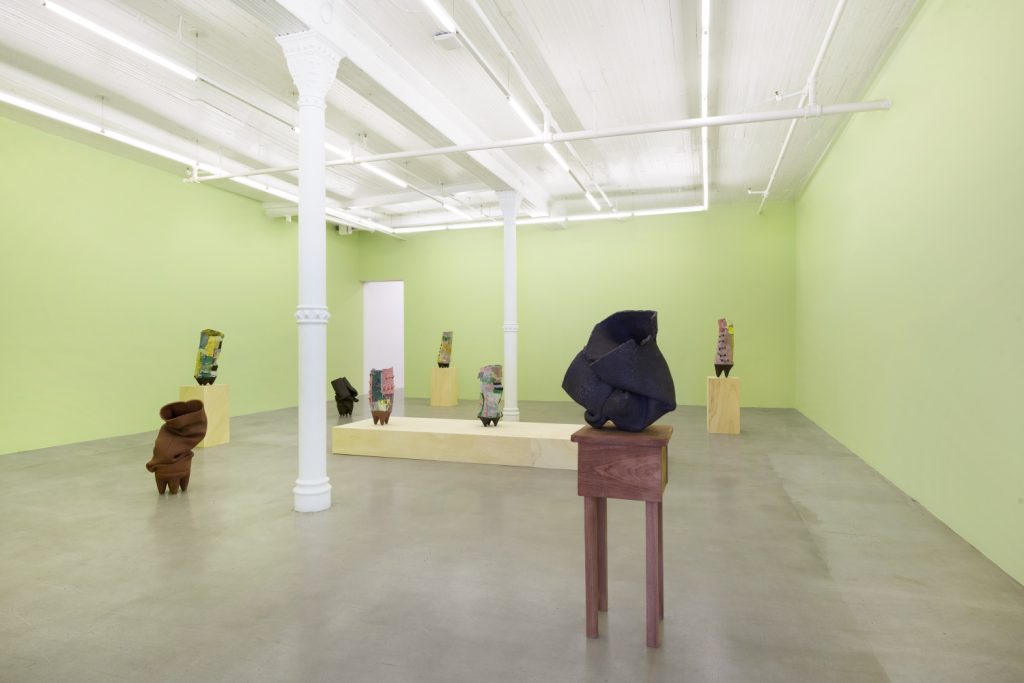
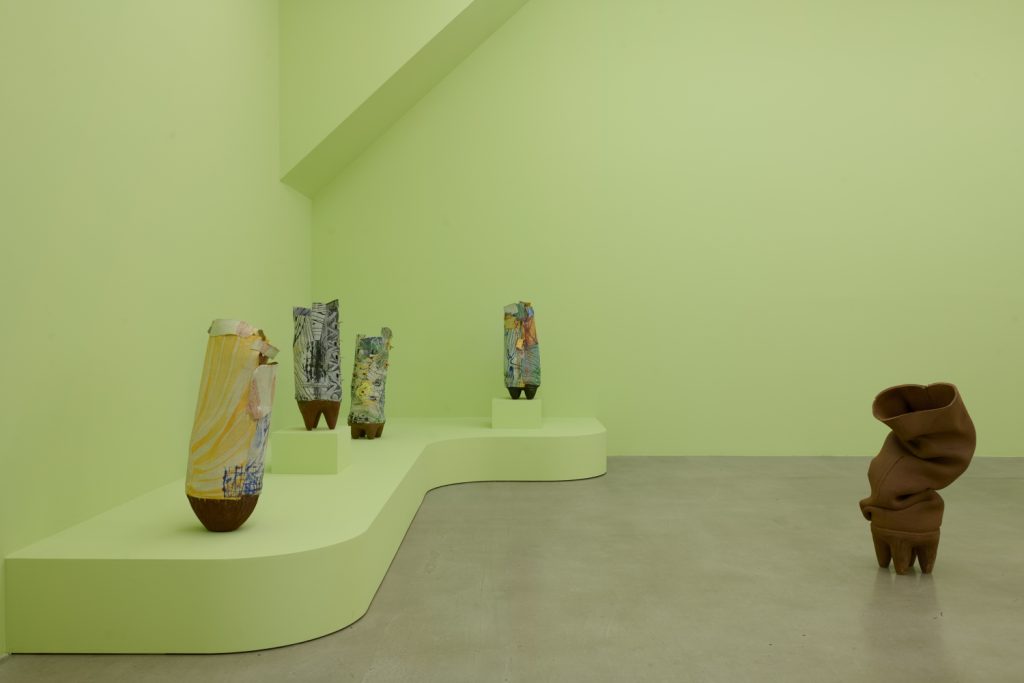
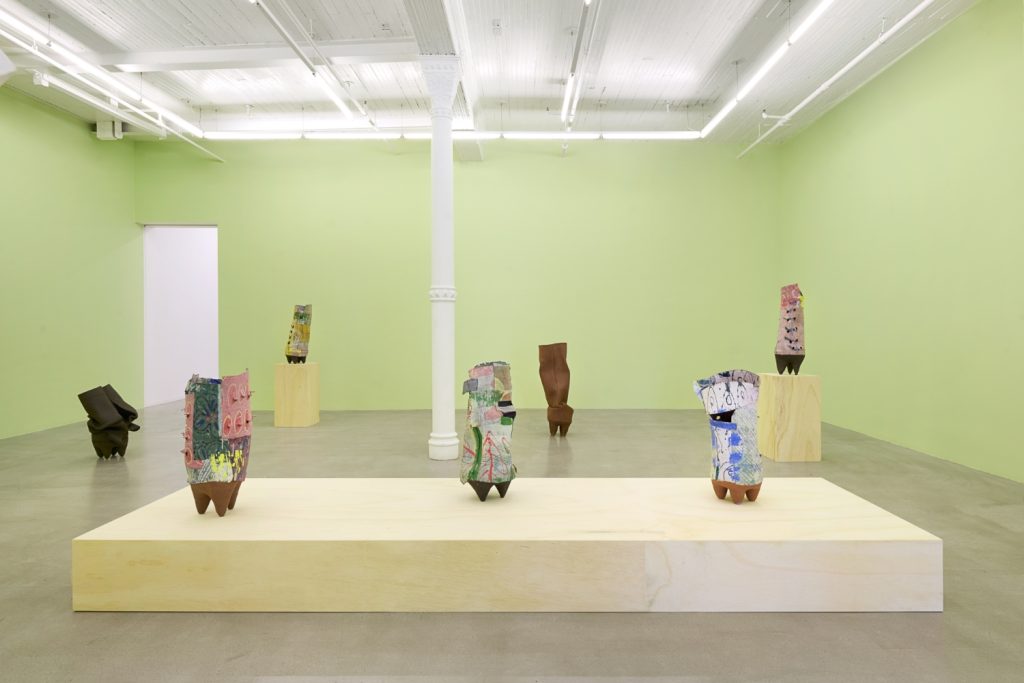
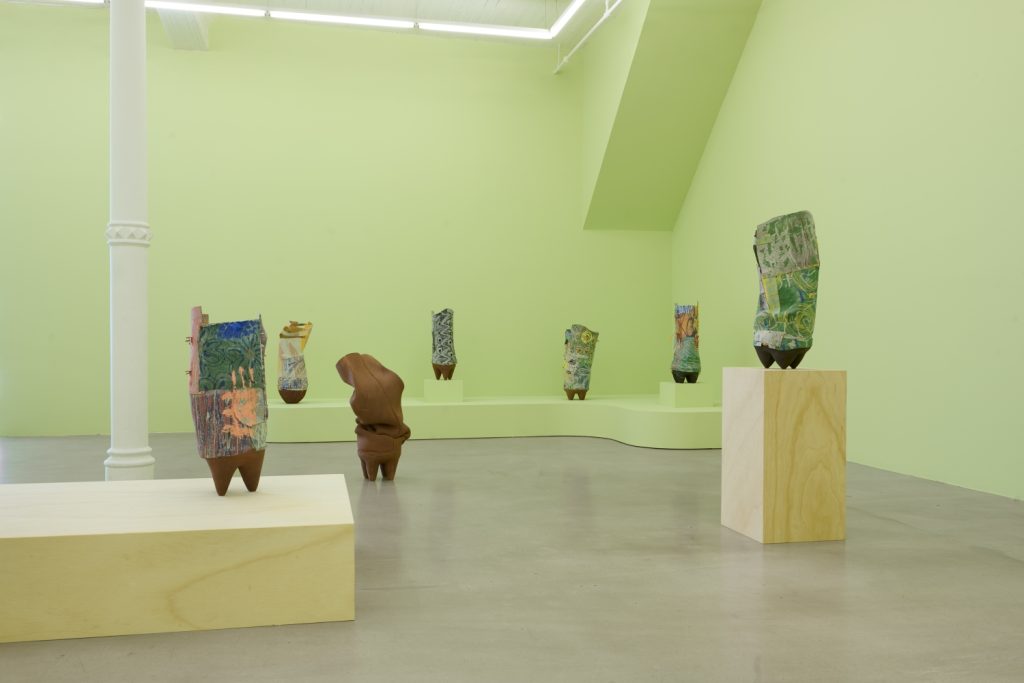
The vessel-like artworks themselves consist of a delicate amalgamation of clay slabs meticulously assembled to the point of structural tension, but still maintaining their own tenuous form in the wet-state of fabrication. Employing colored clay slips, each slab acquires a surface of mono-printed paintings or drawings. The process involves pressing the initial slip configuration, first created on paper, onto the clay form. Additionally, the artist may directly manipulate the surface by overlapping and collaging the clay slabs while in the process of construction. While one could describe this technique akin to a Western style of expressionist gestural painting, its true essence transcends any narrow associations found in Western Euro-American aesthetics. It should be mentioned that the use of color in Yoruba culture holds much significance and, at times, is integrated symbolically. However, the exuberance, manner and use of color found in use here appear more closely aligned and influenced by West African culture instead.
I would also emphasize that the vibrant use of color generally found in West African art is firmly grounded more so in cultural and spiritual contexts, celebrating life, community, and spirituality. In contrast, Abstract Expressionist characterizations found in the West rather prioritize a celebration of personal and individual expression.
The exceptionally thin clay slabs exhibit a fabric-like quality, having been meticulously rolled out onto a coarse, weighty textile, capturing that very same tactile impression prior to assembly.
The evident function of these thin clay slabs serves as diverse ‘skins’ which carry a metaphorical weight, particularly in light of Ranti Bam’s explorations of identity and the conscious and/or unconscious associations that can be further drawn from Yoruba culture. A number of her pieces using a punctured repetition of patterned mark-making alludes to the facial skin scarification that holds deep cultural significance among the Yoruba people of Nigeria. These intricate facial marks and patterns historically found in Yoruba culture and often inscribed during childhood, serve the Yoruba population as both cultural symbols and aesthetic embellishments.1 While once prevalent, it is interesting to note that the practice of scarification has gradually waned due to colonialization and modernization, yet it still remains persistent as a fascinating aspect of the Yoruba people. Ranti’s utilization of this lexicon highlights the hybrid essence of her heritage, drawing inspiration from a rich tapestry that includes Yoruba culture, West African traditions, and influences from Euro-Western society. The repetitive punctures of mark-making and her use of color serve as a testament to the intricate fusion of diverse cultural legacies, coupled with an inherent receptivity to varied socio-cultural and artistic perspectives, which in turn inspires her creativity.
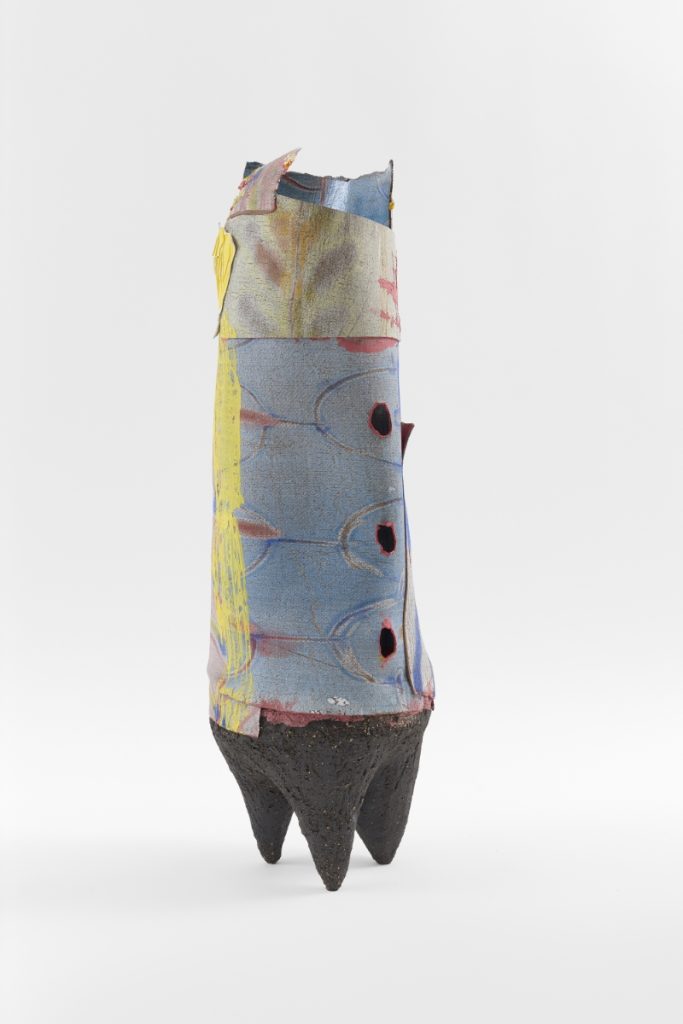
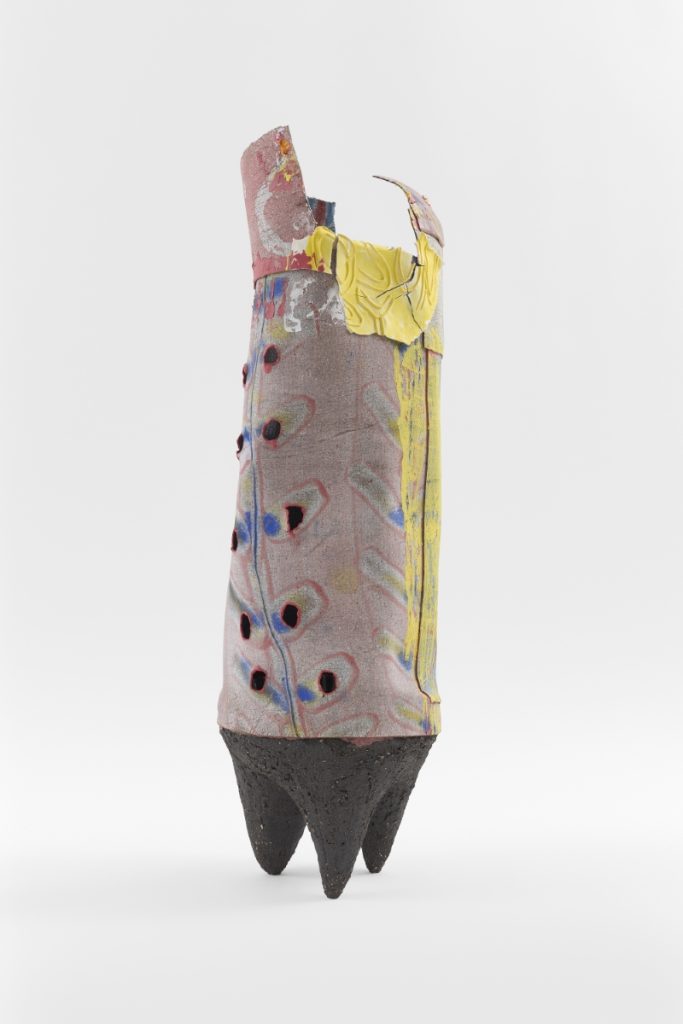
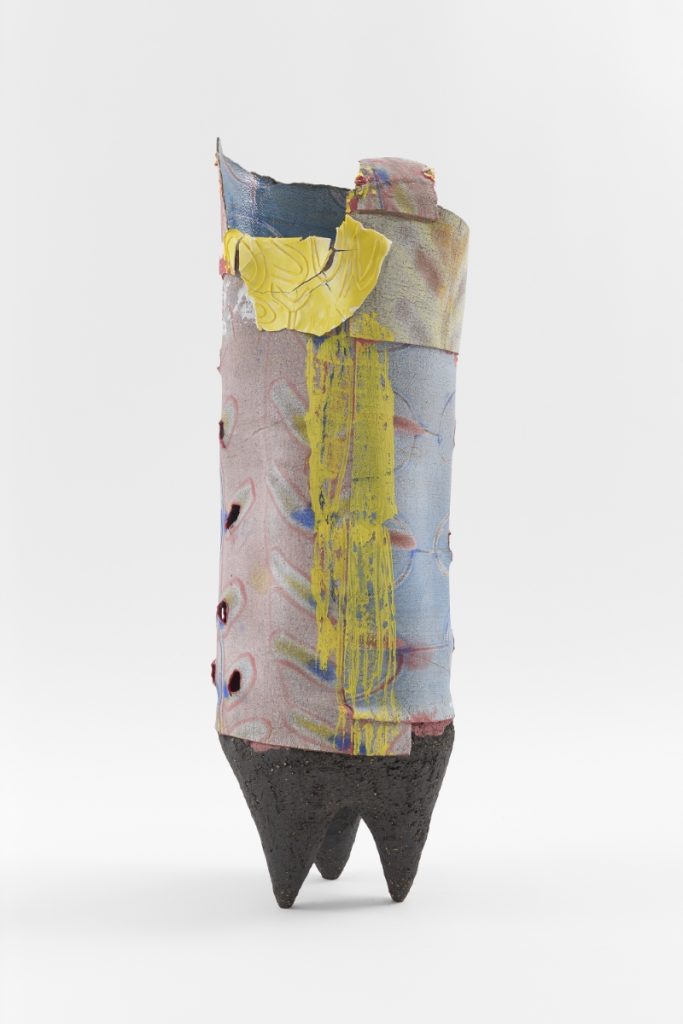
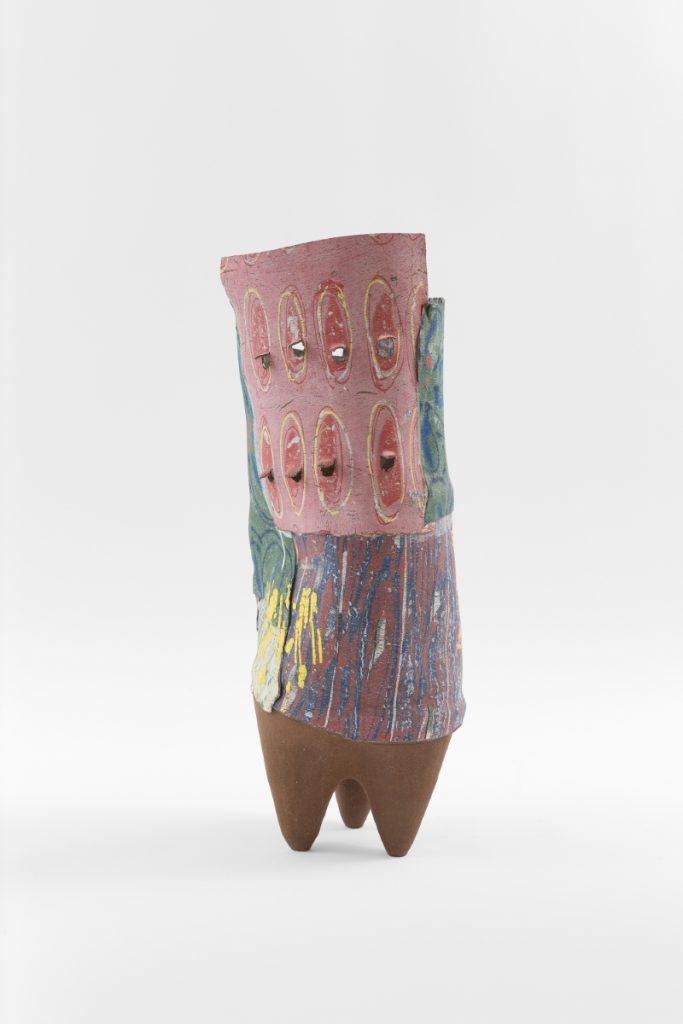
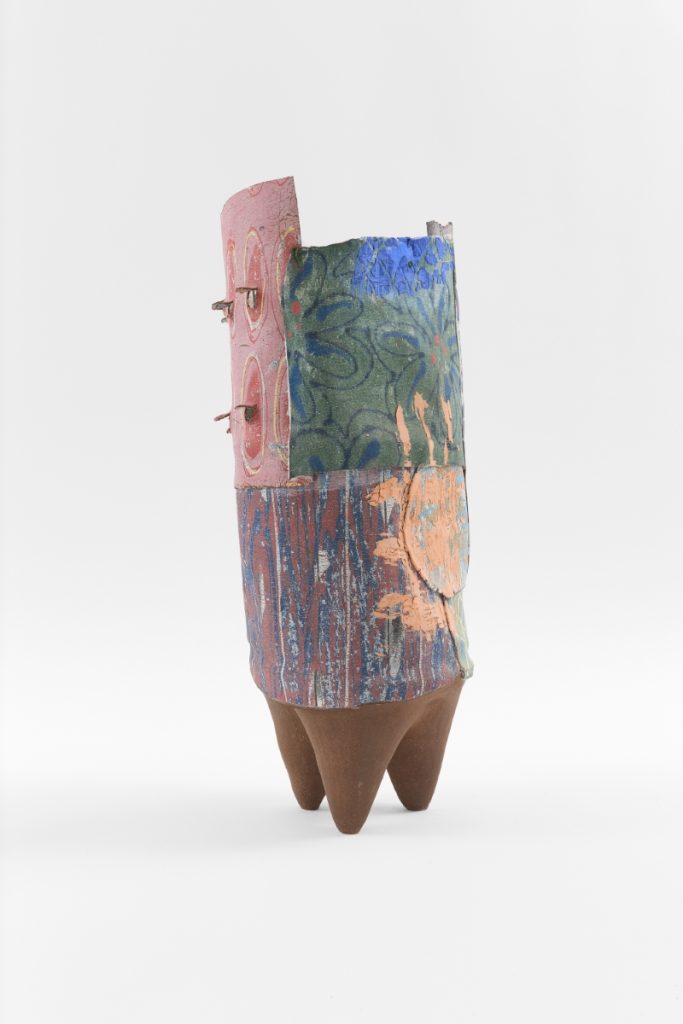
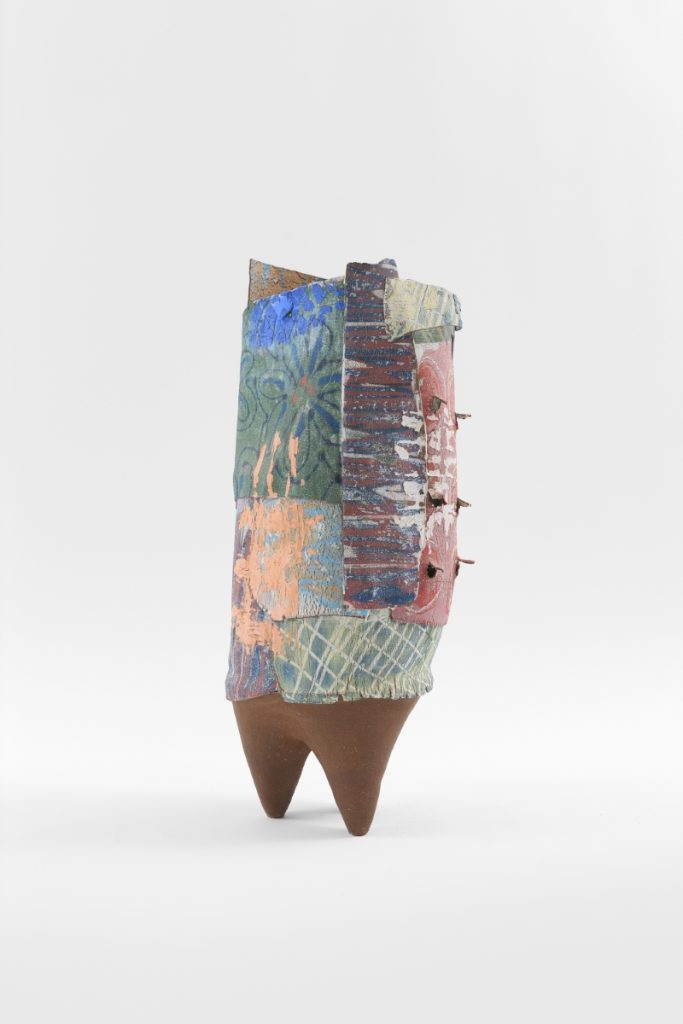
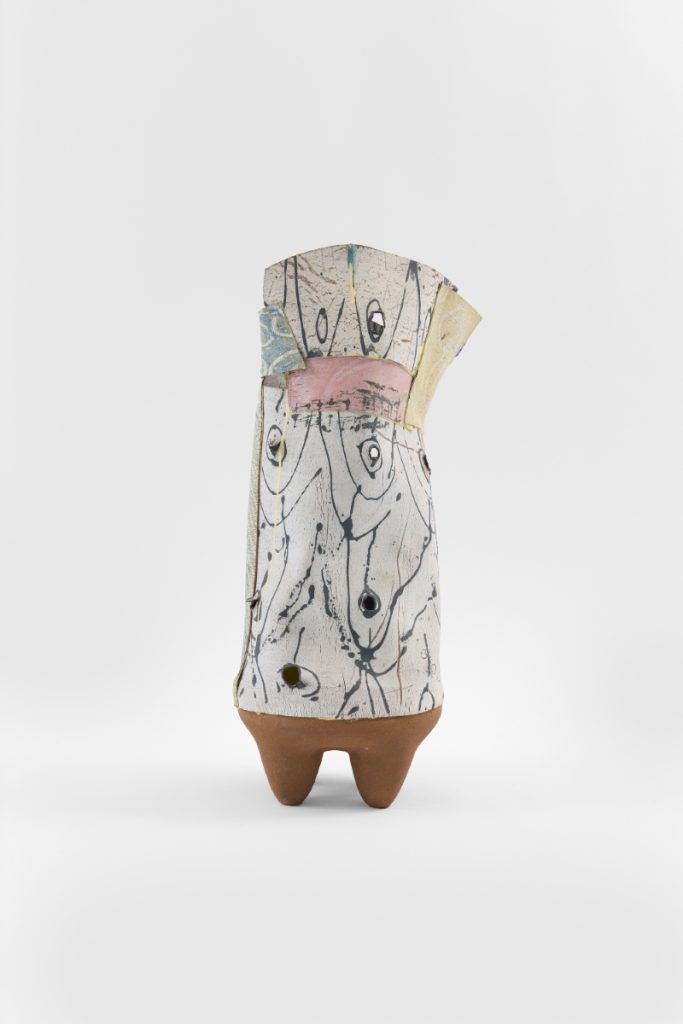
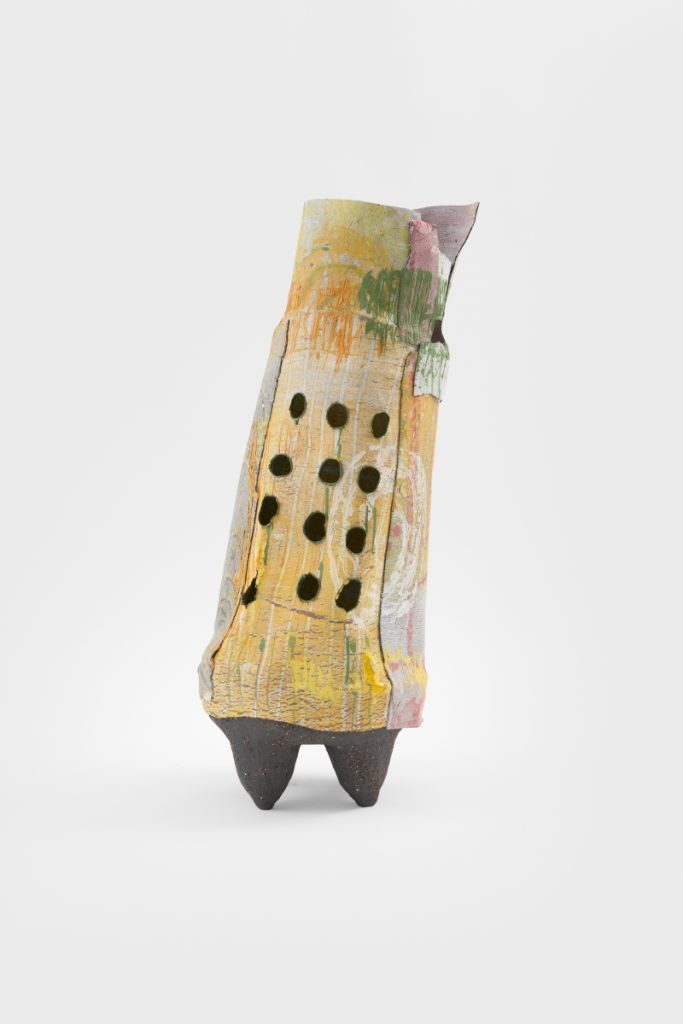
The other artworks featured in this exhibition, titled ‘Ifa,’ exhibit a distinct departure from the exuberant underglaze colors commonly seen in many of the other works. Instead, they take the form of robust clay slab constructions, devoid of any painted embellishments. These pieces evoke the concept of skin tones, rendered in black stoneware and earthenware terracotta hues, left in their raw, unadorned state.
The Ifa works draws inspiration from Yoruba culture, where it holds a revered position as a divination system, said to provide wisdom and guidance. Beyond its religious significance, Ifa also serves as a repository of Yoruba history, ethics, and philosophy, influencing communal decisions and rituals2. Within this exhibition, the artist employs Ifa as a metaphor for the human body, allowing vessel forms of torso-length proportions to bend, fold, and tear under their own weight. Through their creation, these objects become vessels of transformation.
What C.G Jung would say about “Anima” as a title for an art exhibition that reimagines Eve as the primal feminine while not mentioning any masculine attribution would most likely be a faux pas, a major deviation of thought from the Jungian empirical concept. Jung would define anima as the representation of the feminine aspect of a man’s unconscious. Animus representing the masculine component of a woman’s unconscious.3,4 However, nowhere is any sense of the masculine apparent or articulated in this exhibition.
However, I would say that engaging in discourse surrounding Jungian concepts like Anima and Animus in the field of art and within the current political landscape can be likened to traversing a treacherous terrain. That interplay of gender, identity, and societal norms adds an almost overwhelming complexity to this discussion that also oversimplifies an analytical Jungian concept that happens to define, in this case, an exhibition titled “Anima”. While I have long argued for a more anthropological approach to evaluating artworks that embody aesthetic values outside the typical norm of Western thought, discussions like this one necessitate a nuanced approach that acknowledges biological distinctions and individual experiences both typical and atypical. It is essential to approach this conversation about Anima, as an exhibition title, with a sensitivity and an open mind, recognizing that individual experiences and identities can vary widely. However, one might also conclude that in the absence of any artist statement about this exhibition, especially in the complete absence of the anima/masculine context, one is left thinking of the “Anima” title as a mismatch. One would like to say that Anima as a title here is only a “springboard” of inspiration or that it is really just a metaphor. However, accepting this premise would only trivialize the generations of Jungians who have spent their careers working diligently on this very important concept.
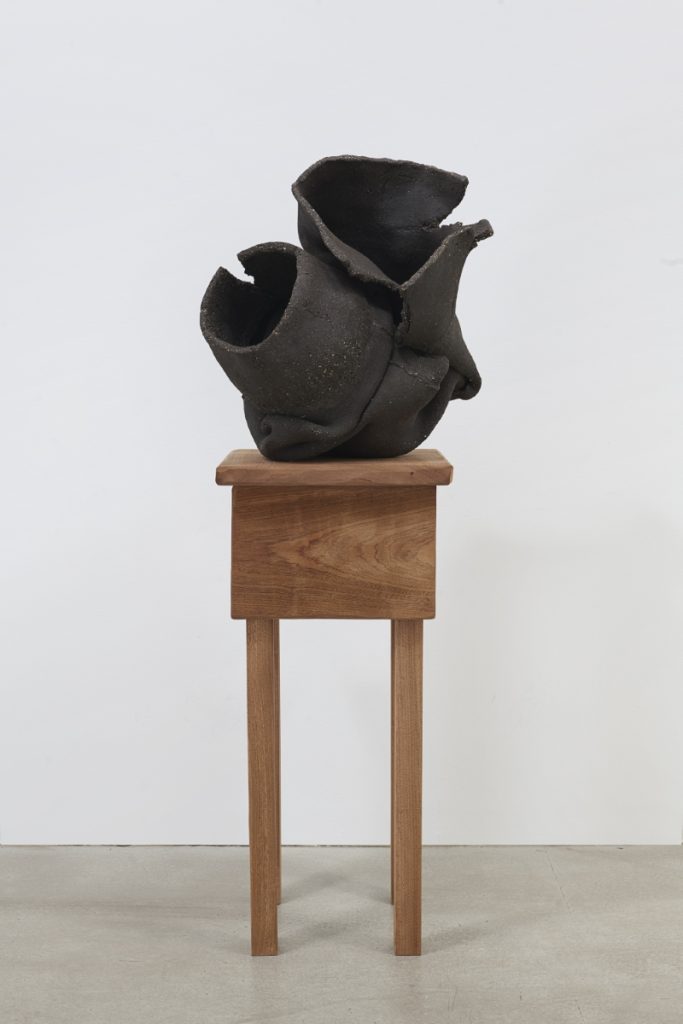
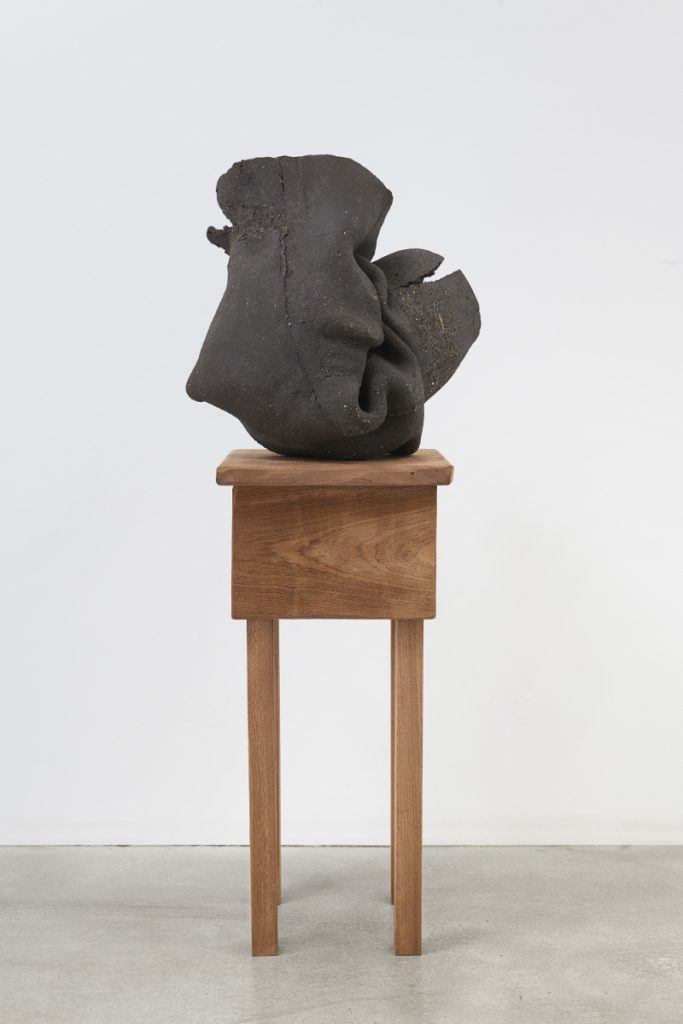
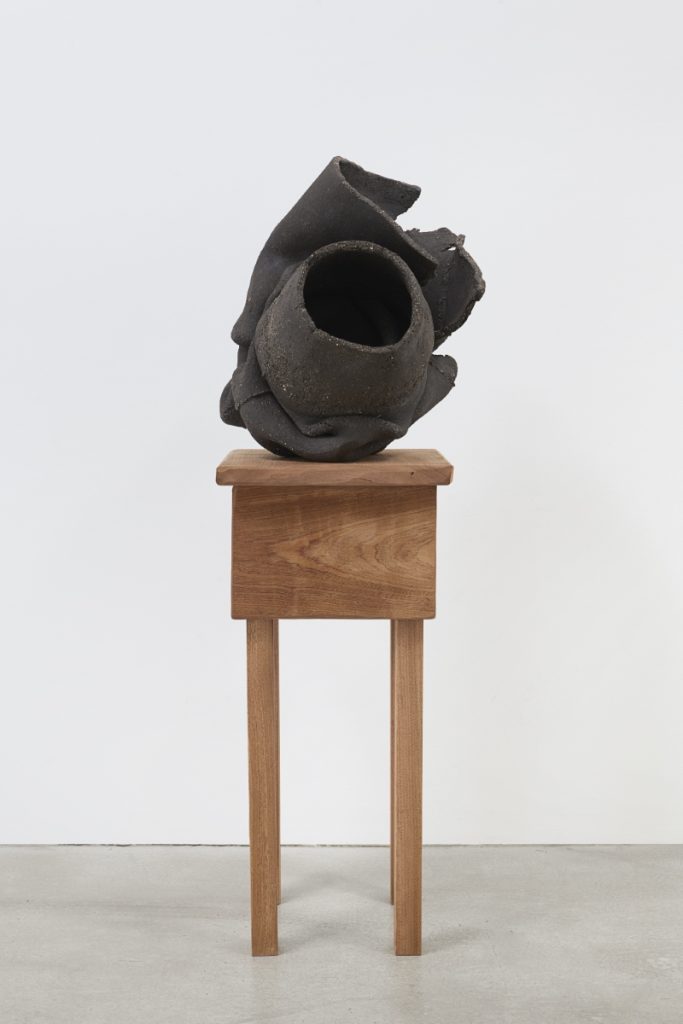
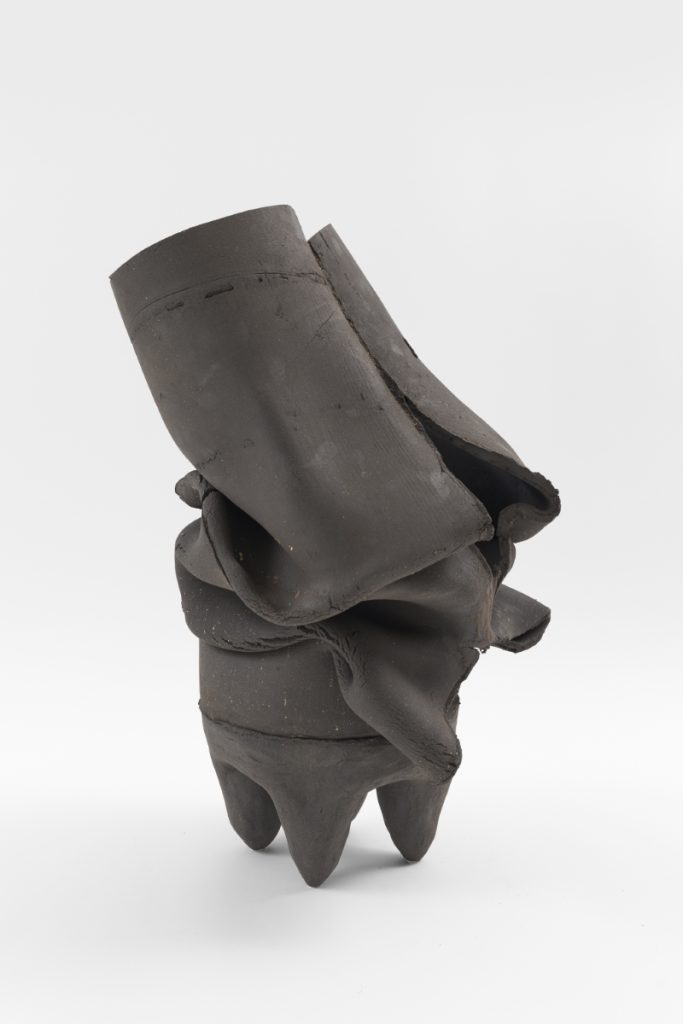
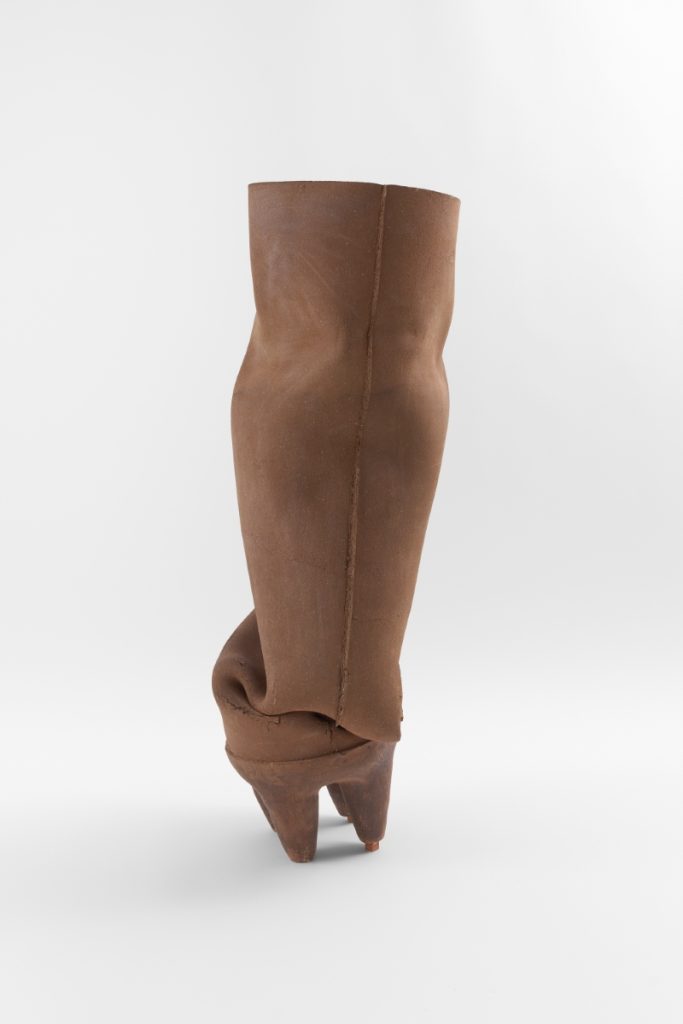
Worth mentioning, we have to remember that C.G Jung was writing his theories about the Anima/Animus concept and the archetypes of the collective unconscious over 100 years ago. He was also a Swiss Caucasian male born in the Victorian era, to a family of pastors whose primary language would have been German. It cannot go without saying that his original concept of Anima has been written about, literally extended and refined for over a century by such notable Jungian scholars as Erich Neumann5, Marie-Louise von Franz6, Jolande Jacobi7, James Hillman8, Robert Johnson9 and Jean Shinoda Bolen10, just to name a select few. It is a literal concept that up to the present day at least, has not clearly recognized post-Jungian structuralists whose movement is away from gender essentialism and towards a post-gender world11. Jung subscribed to a heteronormative and gendered approach to Anima, accounting for how the male psyche conceptualizes the feminine.
Practically and logistically, Ranti Bam’s work draws on a more universal concept of the feminine and one that transcends traditional boundaries. Conceptually, she examines broader societal views of femininity, reflecting these across different contexts but with a contemporary viewpoint. This approach allows for her to chart her own emotional topography, offering a unique and personal commentary while advancing cultural dialogue, promoting inclusivity, and expanding the boundaries of artistic expression. More specifically, the role of the feminine in her work selectively emphasizes intrinsic qualities and values such as empathy, nurturing, and fragility. Her work provides this descriptive and insightful guide to these themes, deepening the viewer’s understanding. Overall, the role of the feminine leads us to a more nuanced understanding of the human experience, and one that often challenges the narrow perspectives that have dominated art historically.
Given the artist’s background, her nascent career trajectory promises a captivating blend of influences, experiences, and artistic growth. As future opportunities arise, it will be fascinating to witness the evolution of her work and the further articulation of her vision. Her focus on the feminine, the Yoruba culture, and her background adds compelling layers of depth to her work that is of significance. It will be intriguing to see how she continues to develop these very optimistic connections.
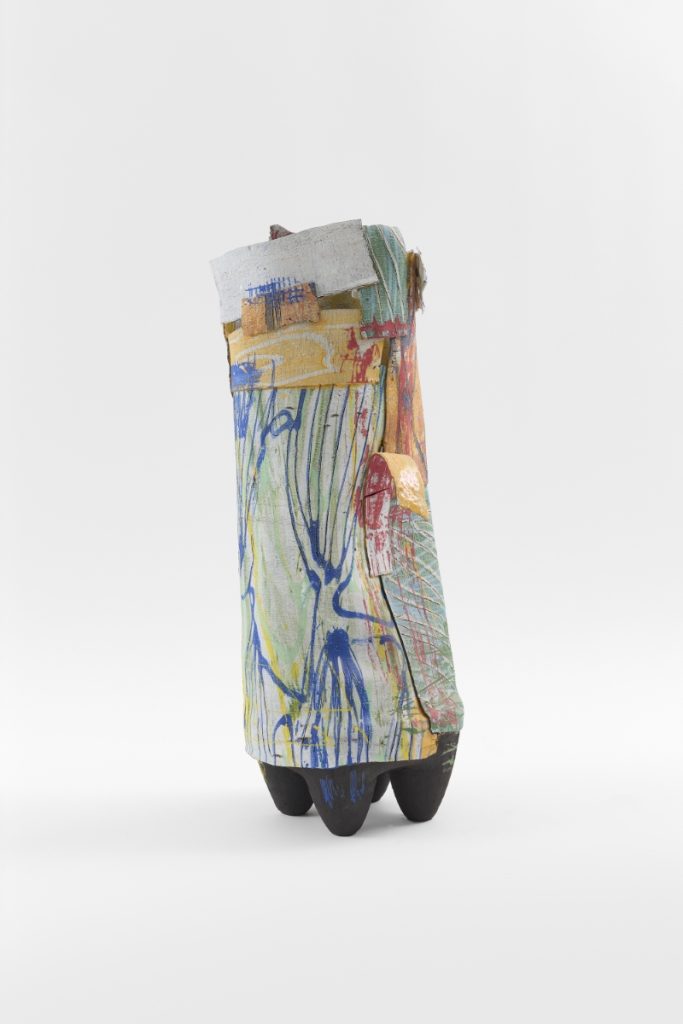

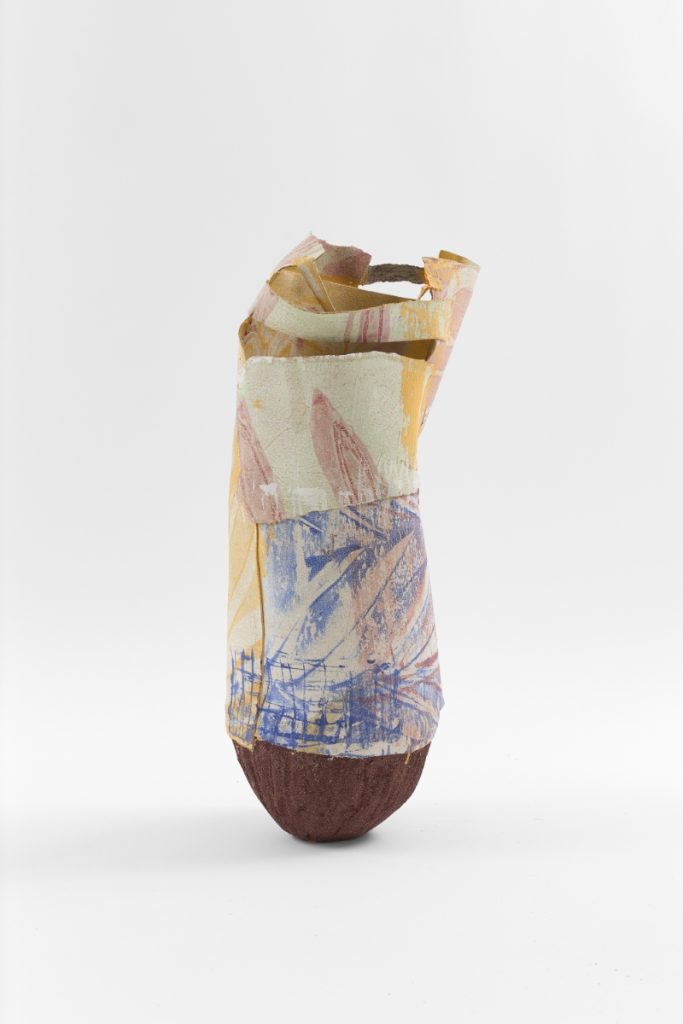
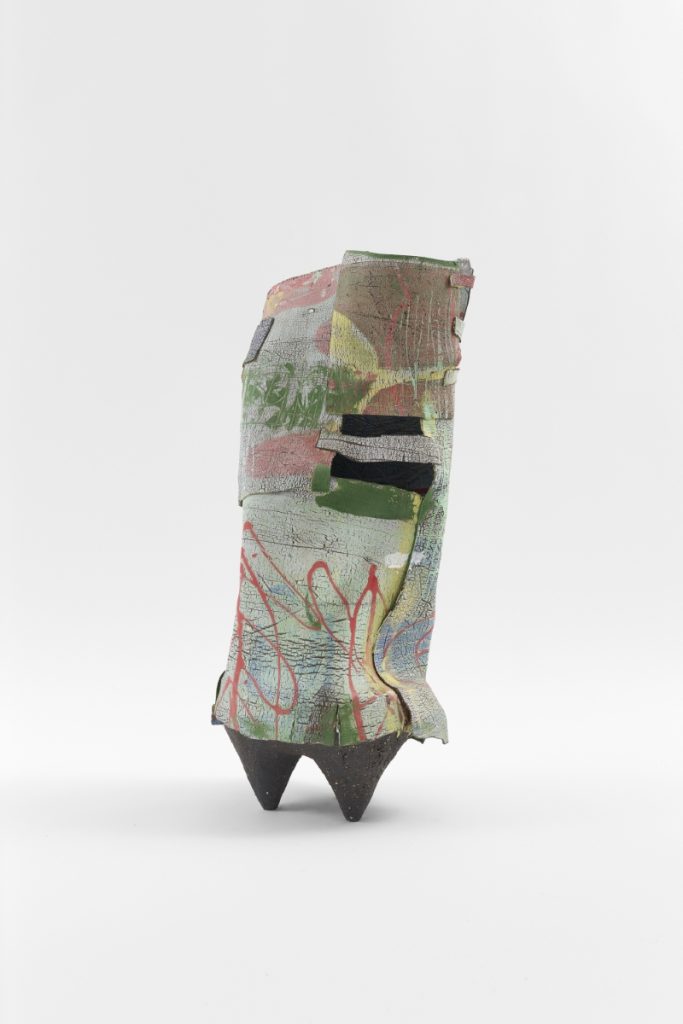
Doug Navarra is a visual artist who has an extensive background in working with clay. He lives in Hudson Valley, New York.
Ranti Bam: Anima was on view at James Cohan Gallery, New York, from May 17 through July 26, 2024. Her work is currently on view at Andréhn-Schiptjenko Gallery, Paris, through October 12, 2024.
Ceramics Now is a reader-supported publication, and memberships enable us to publish high-quality content like this article. Become a member today and help us feature a wider range of voices, perspectives, and expertise in the ceramics community.
Captions
- Installation views by Phoebe d’Heurle. Courtesy of the artist and James Cohan, New York
- Individual images by Matthew Herrmann. Courtesy of the artist and James Cohan, New York
Further reading
- ADÉṢUYÌ, Olúkáyọ̀dé R. – Is there a Place that is Non-Gendered in this World?: A Critique of Oyewumi’s Non Gendered Yorùbá Family, Rupkatha Journal on Interdisciplinary Studies in Humanities, Volume VI, Number 2, 2014. Link
- Drewal, Henry John, – Yoruba: Nine Centuries of African Art and Thought, Harry N. Abrams Inc (January 1, 1990)
- Chaudhary, Nipun – Trans-Cultural Anima, Animus, Shadow and Self: Carl Jung as a Structuralist – Poststructuralist Continuum, International Journal of Recent Technology and engineering (IJRTE) Volume 7, Issue 6S5, April 2019
Footnotes
- Afolabi, Oyeronke – Cultural Identity Through Facial Tribal Marks: A Performing Tradition of the Yoruba Tribe in Nigeria Oyeronke Afolabi Arkansas State University – Jonesboro Conference Paper, May 2023 – See discussions, stats, and author profiles for this publication at this link.
- Ifa divination does not rely on a person having authoritative powers but rather on a system of signs that are interpreted by a diviner. The Ifa divination system is applied whenever an important individual or collective decision has to be made. Link
- Jung, C., Collected Works of C. G. Jung, Archetypes of the Collective Unconscious, Vol. 9, Part 1. 2nd ed., Princeton University Press, 1968. 451 p. (p. 3-41).
- Jeffery, Scott – Carl Jung’s Theory of Anima and Animus: A Detailed Primer of These Two Powerful Archetypes, July 30, 2024. Link
- Neumann, Erich – Fear of the Feminine, Princeton University Press (May 4, 1994)
- von Franz, Marie-Louise – Volume 8 of the Collected Works of Marie-Louise von Franz: An Introduction to the Interpretation of Fairytales & Animus and Anima in Fairytales, Chiron Publications (July 15, 2023)
- Jacobi, Jolande – The Psychology of C.G. Jung, Yale University Press (September 10, 1973)
- Hillman, James – Anima: An Anatomy of a Personified Notion, Spring Publications 2nd edition (July 1, 1985)
- Johnson, Robert – She, Understanding Feminine Psychology, Harper Perennial (March 24, 2020)
- Shinoda Bolen, Jean – Goddesses in Everywoman: Powerful Archetypes in Women’s Lives, Harper Paperbacks; 13th edition (July 1, 2014)
- Farah, Stephen, The Anima: in a Post-Jungian Perspective. Centre of Applied Jungian Studies. This essay also states the classical concept of Anima. Link


